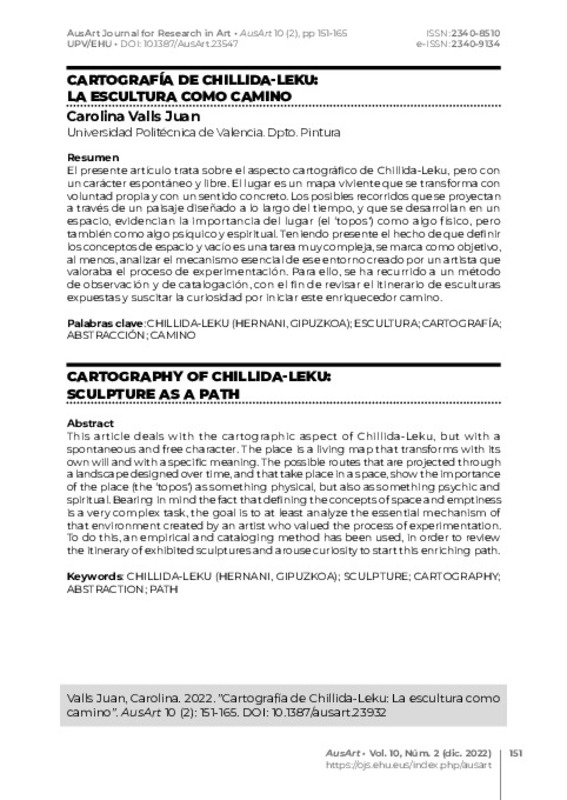JavaScript is disabled for your browser. Some features of this site may not work without it.
Buscar en RiuNet
Listar
Mi cuenta
Estadísticas
Ayuda RiuNet
Admin. UPV
Cartografía de Chillida-Leku. La escultura como camino
Mostrar el registro sencillo del ítem
Ficheros en el ítem
| dc.contributor.author | Valls-Juan, Carolina
|
es_ES |
| dc.date.accessioned | 2023-11-22T19:02:28Z | |
| dc.date.available | 2023-11-22T19:02:28Z | |
| dc.date.issued | 2022-12-02 | es_ES |
| dc.identifier.issn | 2340-8510 | es_ES |
| dc.identifier.uri | http://hdl.handle.net/10251/200126 | |
| dc.description.abstract | [ES] El presente artículo trata sobre el aspecto cartográfico de Chillida-Leku, pero con un carácter espontáneo y libre. El lugar es un mapa viviente que se transforma con voluntad propia y con un sentido concreto. Los posibles recorridos que se proyectan a través de un paisaje diseñado a lo largo del tiempo, y que se desarrollan en un espacio, evidencian la importancia del lugar (el `topos¿) como algo físico, pero también como algo psíquico y espiritual. Teniendo presente el hecho de que definir los conceptos de espacio y vacío es una tarea muy compleja, se marca como objetivo, al menos, analizar el mecanismo esencial de ese entorno creado por un artista que valoraba el proceso de experimentación. Para ello, se ha recurrido a un método de observación y de catalogación, con el fin de revisar el itinerario de esculturas expuestas y suscitar la curiosidad por iniciar este enriquecedor camino. | es_ES |
| dc.description.abstract | [EN] This article deals with the cartographic aspect of Chillida-Leku, but with a spontaneous and free character. The place is a living map that transforms with its own will and with a specific meaning. The possible routes that are projected through a landscape designed over time, and that take place in a space, show the importance of the place (the `topos¿) as something physical, but also as something psychic and spiritual. Bearing in mind the fact that defining the concepts of space and emptiness is a very complex task, the goal is to at least analyze the essential mechanism of that environment created by an artist who valued the process of experimentation. To do this, an empirical and cataloging method has been used, in order to review the itinerary of exhibited sculptures and arouse curiosity to start this enriching path. | es_ES |
| dc.language | Español | es_ES |
| dc.publisher | UPV/EHU Press | es_ES |
| dc.relation.ispartof | AusArt | es_ES |
| dc.rights | Reconocimiento - Compartir igual (by-sa) | es_ES |
| dc.subject | Chillida-Leku (Hernani, Gipuzkoa) | es_ES |
| dc.subject | Escultura | es_ES |
| dc.subject | Cartografía | es_ES |
| dc.subject | Abstracción | es_ES |
| dc.subject | Camino | es_ES |
| dc.subject | Sculpture | es_ES |
| dc.subject | Cartography | es_ES |
| dc.subject | Abstraction | es_ES |
| dc.subject | Path | es_ES |
| dc.subject.classification | PINTURA | es_ES |
| dc.title | Cartografía de Chillida-Leku. La escultura como camino | es_ES |
| dc.title.alternative | Cartography of Chillida-Leku. Sculpture as a path | es_ES |
| dc.type | Artículo | es_ES |
| dc.identifier.doi | 10.1387/ausart.23932 | es_ES |
| dc.rights.accessRights | Abierto | es_ES |
| dc.contributor.affiliation | Universitat Politècnica de València. Facultad de Bellas Artes - Facultat de Belles Arts | es_ES |
| dc.description.bibliographicCitation | Valls-Juan, C. (2022). Cartografía de Chillida-Leku. La escultura como camino. AusArt. 10(2):151-165. https://doi.org/10.1387/ausart.23932 | es_ES |
| dc.description.accrualMethod | S | es_ES |
| dc.relation.publisherversion | https://doi.org/10.1387/ausart.23932 | es_ES |
| dc.description.upvformatpinicio | 151 | es_ES |
| dc.description.upvformatpfin | 165 | es_ES |
| dc.type.version | info:eu-repo/semantics/publishedVersion | es_ES |
| dc.description.volume | 10 | es_ES |
| dc.description.issue | 2 | es_ES |
| dc.relation.pasarela | S\480250 | es_ES |








